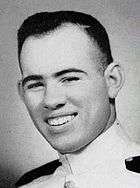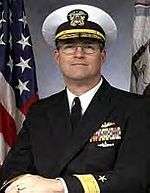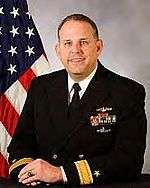Hispanic Admirals in the United States Navy
| Hispanic Admirals in the United States Navy | |||||||
|---|---|---|---|---|---|---|---|
|
|
Hispanic Admirals in the United States Navy can trace their tradition of naval military service to the Hispanic sailors, who have served in the Navy during every war and conflict since the American Revolution. Prior to the Civil War, the highest rank reached by a Hispanic-American in the U.S. Navy was Commodore. Such was the case of Commodore Uriah Phillips Levy (1792–1862), a Sephardic Jew of Hispanic descent and great grandson of Dr. Samuel Nunez,[1] who served in the War of 1812.[2][3][4] During the American Civil War, the government of the United States recognized that the rapid expanding Navy was in need of admirals therefore, Congress proceeded to authorize the appointment of nine officers the rank of rear admiral.[5][6] On July 16, 1862, Flag Officer David Glasgow Farragut became the first Hispanic-American to be appointed to the rank of rear admiral.[7][8] Two years later (1864), Farragut became a vice admiral, and in 1866 the Navy's first full admiral. During World War I, Robert Lopez, the first Hispanic graduate of the United States Naval Academy, served with the rank of commodore in command of the Mare Island Naval Shipyard, and during World War II five Hispanics served with the ranks of rear admiral or above in either the European or Pacific Theater's of the war. As of April 2007, twenty-two Hispanic-Americans have reached the rank of admiral, and of this number thirteen were graduates of the USNA.
Terminology
Admiral, a word that stems from the Arabic term Amir-al-bahr (commander of the sea),[9] is the rank, or part of the name of the ranks, of the highest naval officers. Admirals are the highest-ranking officers in the U.S. Navy. However, through the American Revolution until 1862, the U.S. Navy had no admiral rank.[6][10]
Hispanic American is an ethnic term employed to categorize any citizen or resident of the United States, of any racial background, of any country, and of any religion, who has at least one ancestor from the people of Spain or is of non-Hispanic origin, but has an ancestor from Mexico, Puerto Rico, Cuba, Central or South America, or some other Hispanic origin. The three largest Hispanic groups in the United States are the Mexican-Americans, Puerto Ricans and Cubans.[11][12][13]
David Glasgow Farragut
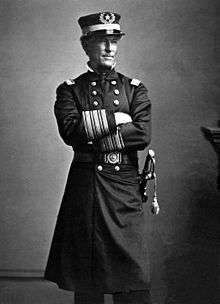
Born on July 5, 1801 at Campbell's Station, near Knoxville, Tennessee, David Glasgow Farragut (born James Farragut) was the second son of Elizabeth Farragut and her husband Jorge Farragut Mesquida, a Spanish–Catalan by descent and a Minorquin by birth, who had emigrated to America in 1776. Jorge Farragut Mesquida served during the American Revolution. In 1808, Farragut's mother died from yellow fever and his father then gave him up for adoption. He was adopted by future-U.S. Navy Captain David Porter.[8]
Farragut entered the Navy as a midshipman on December 17, 1810. His first naval combat experience came in the War of 1812, when the ship to which he was assigned, the Essex, captured an enemy vessel and, at the age of 12 years he was given the assignment to bring the ship safely to port.[8]
Civil War
In April 1862, Farragut was the "flag officer" in command of the West Gulf Blockading Squadron. With his flagship, the Hartford, he ran past Fort Jackson and Fort St. Philip and the Chalmette, Louisiana, batteries to take the city and port of New Orleans, Louisiana. This victory was an influential factor when in 1862, Congress created the rank of admiral and named Farragut and eight other naval officers (which also included his foster brother David Dixon Porter) as rear admirals. Thus, Farragut became the first Hispanic-American admiral in the United States Navy.[8]
Farragut's greatest victory was the Battle of Mobile Bay on August 5, 1864. Mobile, Alabama at the time was the Confederacy's last major port open on the Gulf of Mexico. The bay was heavily mined with tethered naval mines, also known as torpedoes. When the Tecumseh, one of the ships under his command, struck a mine and went down, Farragut shouted through a trumpet from his flagship to the Brooklyn, "What's the trouble?" "Torpedoes!" was the reply. Farragut then shouted his now famous words "Damn the torpedoes! Full speed ahead!" The fleet succeeded in entering the bay. Farragut then triumphed over the opposition of heavy batteries in Fort Morgan and Fort Gaines to defeat the squadron of Admiral Franklin Buchanan.[8][14]
Farragut was promoted to vice admiral on December 21, 1864, and to full admiral (which at the time was three stars) on July 25, 1866, after the war, thereby becoming the first person to be named full admiral in the Navy's history.[15]
United States Naval Academy
The United States Naval Academy (USNA) is an institution for the undergraduate education of officers of the United States Navy and Marine Corps. The institution was founded as the Naval School in 1845 by Secretary of the Navy George Bancroft.[16]
The first Hispanic-American to graduate from the academy to reach the rank of admiral was Robert F. Lopez, class of 1879. Lopez was a Commodore during World War I, which technically made him the first Hispanic alumnus to become an admiral.[17][18][19] Commodore is an official flag rank when used during wartime and is equivalent to today's one-star admiral – rear admiral (lower half). Many rank systems only use this rank during wartime.[18] The first Hispanic alumnus, born outside of the United States mainland, to graduate from the academy and to reach the rank of admiral was Rear Admiral Frederick Lois Riefkohl, a Puerto Rican who graduated in the class of 1911.[18]
The academy's Hispanic alumni
- Commodore Robert F. Lopez, USN – USNA Class of 1879. Born in Davenport, Iowa. Appointed from Tennessee, 9th Congressional District, Lopez was admitted to the USNA on September 29, 1874. Lopez retired from the Navy in 1911 as a captain. During World War I, he was recalled to active duty and given the rank of commodore (equivalent to a one-star admiral rank, typically used during wartime[20]) to command the Mare Island Naval Shipyard.[18][21]
- Rear Admiral Frederick Lois Riefkohl, USN – USNA Class of 1911. Born and raised in Maunabo, Puerto Rico, he is the first Puerto Rican to graduate from the Naval Academy. He was a World War I Navy Cross recipient who served as captain of the heavy cruiser Vincennes during World War II.[22][23][24]
- Rear Admiral Jose M. Cabanillas, USN – USNA Class of 1924. Born in Mayagüez, Puerto Rico, was an executive officer of the battleship Texas, which participated in the invasions of North Africa and Normandy (D-Day) during World War II. In 1945, he became the first commanding officer of the attack transport Grundy.[25]
- Rear Admiral Edmund Ernest García, USN – USNA Class of 1927. Born in San Juan, Puerto Rico, his father Enrique Garcia was a captain in the U.S. Army. He was originally a member of the Class of 1926 but requested to be turned back to the class of 1927 for academic deficiency in mathematics. During World War II was commander of the destroyer Sloat, and saw action in the invasions of Africa, Sicily, and France.[26]
- Rear Admiral Henry G. Sanchez, USN – USNA Class of 1930. Born on December 29, 1907. During World War II, then-LCDR Sanchez commanded VF-72, an F4F squadron of 37 aircraft, on board the carrier Hornet from July to October 1942. His squadron was responsible for shooting down 38 Japanese airplanes during his command tour which included the Battle of the Santa Cruz Islands.[27]
- Admiral Horacio Rivero, Jr., USN – USNA Class of 1931. Was the first four-star admiral from Puerto Rico and the second Hispanic-American full admiral, after Admiral David Farragut, in the Navy. Born in Ponce, Puerto Rico and graduated third in his USNA class. During World War II, he served aboard the light cruiser San Juan and was involved in providing artillery cover for Marines landing on Guadalcanal, Marshall Islands, Iwo Jima, and Okinawa. In October 1962, Admiral Rivero found himself in the middle of the Cuban Missile Crisis. As Commander of amphibious forces, Atlantic Fleet, he was on the front line of the vessels sent to the Caribbean by President Kennedy to stop the Cold War from escalating into World War III.[28][29]
- Rear Admiral Rafael Celestino Benítez, USN – USNA Class of 1939. Born in Juncos, Puerto Rico, was a Lieutenant Commander and saw action aboard submarines and on various occasions weathered depth charge attacks. For his actions, he was awarded the Silver and Bronze Stars. Benitez would later play an important role in the first American undersea spy mission of the Cold War as commander of the submarine Cochino in what became known as the "Cochino Incident".[30][31]
- Vice Admiral Jesse J. Hernandez, USN – USNA Class of 1958. Hernandez was the commander of US Naval Forces Japan from 1990 to 1993.[32]
- Rear Admiral Benjamin F. Montoya, USN – USNA Class of 1958 (Ret.). A native of Indio, California, Montoya served in various positions during his naval career. Montoya's academic accomplishments include a civil engineering degree from Rensselaer Polytechnic Institute, a master's degree in environmental engineering from Georgia Tech and a law degree from Georgetown University. He was the chief of the Navy Civil Engineer Corps and commander of the Naval Facilities Engineering Command.[33]
- Rear Admiral Henry F. Herrera, USN – USNA Class of 1966.(Ret.) Herrera was born in Miami Springs, Florida, is the president of the Board of Inspection and Survey, the commander of Submarine Group NINE, and the director of C41 Systems (J-6), U.S. Strategic Command. He had previously, served as the commanding officer of two fleet ballistic missile submarines.[34][35][36]
- Rear Admiral Marc Y.E. Pelaez, USN – USNA Class of 1968 (Ret.). Pelaez served in various positions in the Navy during his career, among them commanding officer of nuclear-powered attack submarine Sunfish. From 1990 to 1993 he served as the executive assistant to the Assistant Secretary of the Navy, and from 1993 to 1996 as director of submarine technology at the Defense Advanced Research Projects Agency (DARPA), and chief of the Office of Naval Research. As a civilian he serves as director of Technology / Scientific and Technical Instruments at II-VI Incorporated, Saxonburg, Pennsylvania.[37][38]
- Rear Admiral George "Rico" Mayer, USN – USNA Class of 1975. Born and raised in Puerto Rico, became a naval aviator and assumed his current assignment as commander of the Naval Safety Center, in August 2005. Mayer earned a master's degree from the U.S. Naval War College.[39][40]
- Rear Admiral Jay A. DeLoach, USN – USNA Class of 1978. Born in San Diego, California, His academic background include a Bachelor of Science degree in marine engineering and two master's degree; Master of Arts in Management & Supervision and Masters of Engineering in Nuclear Engineering. DeLoach is the assistant deputy chief of naval operations for resources, requirements and assessments. DeLoach played an instrumental role in implementing a visionary "Memorandum of Understanding" between the Submarine Force Active component and the Reserve component. He helped pioneer many key initiatives that have since been adopted Navy-wide.[41][42]
- Rear Admiral Patrick H. Brady, USN – USNA Class of 1981. Born in Camp Springs, Maryland is the deputy director of the Submarine Warfare Division (N87B). Brady, who is of Irish and Hispanic descent graduated from the United States Naval Academy in 1981 with a Bachelor of Science in Ocean Engineering. Brady's academic accomplishments also include a Master of Arts in National Security Affairs from the Naval Postgraduate School. He attended the Air Force Command and Staff College, and completed Navy Nuclear Power training and Level Three acquisition training. Prior to his current position, Brady was the commander of the Naval Undersea Warfare Center.[43]
Other Hispanic Admirals

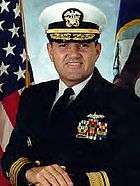
There are also some members of the Navy who reached the rank of admiral and who were not graduates of the Naval Academy. These were men who had earned specialized degrees and then chose to serve in the Navy. The following are the Hispanic admirals who are not alumni of the Academy.
- Rear Admiral Jose Luis Betancourt, Jr. (Surface Warfare) (Ret.), was commander of the Mine Warfare Command, headquartered at Naval Air Station (NAS) Corpus Christi, Texas. Betancourt, who was born in Mexico, had previously served aboard the LST Frederick, destroyer John S. McCain, frigate William H. Standley, and as executive officer of the cruiser Fox. He served as commanding officer of the destroyer Merrill, during its deployment to the Persian Gulf during Operation Desert Storm, where during extensive mine clearance operations his ship served as flagship. Betancourt, served in various positions, among them commanding officer of the amphibious assault ship Peleliu, special assistant for Officer Accession Programs, Office of the Chief of Naval Personnel at Washington, D.C. and in the International Military Staff at NATO Headquarters in Brussels, Belgium before being named commander of the Mine Warfare Command. In this position he was responsible for the development of the Navy's mining strategy and the Navy's inventory of underwater mines among other tasks.[44][45]
- Rear Admiral Alberto Díaz, Jr. (Medical Corps) (Ret.), born in San Juan, Puerto Rico, earned a Bachelor of Arts degree from George Washington University and a master's degree in psychology from Butler University. He earned his medical degree from the University of Barcelona Medical School in Barcelona, Spain. Diaz was the first Hispanic to become the director of the San Diego Naval District and Balboa Naval Hospital.[46][47]
- Rear Admiral Philip A. Dur (Ret.), born in Bethesda, Maryland, earned a bachelor's degree in Government and International Studies and a master's degree in Soviet East European studies from the University of Notre Dame. He also earned a master's degree in Public Administration and a Ph.D. in Political Economy and Government from Harvard University. Dur served as Assistant Deputy Chief of Naval Operations; director of the Navy Strategy Division; commander of the Battle Force United States Sixth Fleet; commander of Cruiser Destroyer Group EIGHT; United States Defense Attaché accredited to the Government of France; commanding officer, Yorktown; and director of the Political Military Affairs on the staff of the National Security Council.[48]
- Rear Admiral Alvaro R. Gomez (Ret.) born in Brooklyn, New York, earned a bachelor's degree in history from St. Johns University and a Master of Science degree in business administration from George Washington University.[49]
- Vice Admiral Diego E. Hernández (Ret.), born in San Juan, was the first Hispanic to be named vice commander of the North American Aerospace Defense Command (NORAD). Hernandez as commander of the Third Fleet, coordinated RIMPAC '88, a massive naval exercise which included more than 40 ships, approximately 200 aircraft and more than 50,000 sailors, airmen and Marines from the United States, Japan, Australia and Canada. This exercise marked the first inclusion of a battleship, the Missouri, as a component in RIMPAC.[50][51]
- Rear Admiral Rodrigo C. Melendez (Dental Corps) (Ret.), from Los Angeles, California, joined a Navy Dental Student Early Commissioning Program during his freshmen year in Dental School. He earned Bachelor of Science and Doctor of Dental Surgery degrees from the University of Southern California and a Master of Science degree from George Washington University. He served as Assistant Chief for Education, Training and Personnel, Bureau of Medicine and Surgery in Washington, D.C.[52][53]
Currently
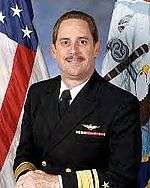
As of April 2007, there are four admirals in the Navy of Hispanic descent. They are:
- Rear Admiral Albert Garcia, Civil Engineer Corps, from Round Rock, Texas. His academic background includes a Bachelor of Science, Master of Science, and Ph.D. in Environmental Engineering form Texas A&M University. Garcia has served as commanding officer of Officer in Charge of Construction, Atlantic; Commodore for the 9th Naval Construction Regiment; Assistant Chief of Staff for Reserve Affairs in the First Naval Construction Division; he commanded Task Force Charlie of the MEF Engineering Group and later was assigned as the Deputy Commander of the MEF Engineering Group in Iraq. In 2004 he assumed responsibility for consolidating several reserve augment units into a new command, NAVFAC Contingency OICC. He assumed the duties of Deputy Commander of the First Naval Construction Division in August 2005.[54]
- Rear Admiral Will Rodriguez, Engineering Duty Officer. Born in Portsmouth, Virginia, His father was Captain William Primitivo Rodriguez, USN, a 1954 graduate of the U.S. Naval Academy. Rodriguez has been the Chief Engineer for the Space and Naval Warfare Systems Command (SPAWAR 05). Between November 2005 and February 2006, he was the Acting Commander for SPAWAR as well. Rodriguez's academic background includes a bachelor's degree in Mathematics and Computer Science and a Master of Science Degree in Systems Technology (Command, Control and Communications with emphasis in Computer Science and Communications Engineering).[55]
- Rear Admiral George 'Rico' Mayer (See: The academy's Hispanic alumni above)
- Rear Admiral Patrick H. Brady (See: The academy's Hispanic alumni above)
See also
- Hispanics in the United States Naval Academy
- Hispanics in the United States Navy
- Hispanics in the United States Coast Guard
- Hispanics in the United States Marine Corps
- Hispanics in the United States Air Force
- Hispanic Americans in World War II
- Hispanics in the American Civil War
- History of the United States Navy
- List of United States Navy people
- List of Hispanic Medal of Honor recipients
References
- ↑ Uriah P. Levy, retrieved October 2, 2007
- ↑ THE COMMODORE THE ADVENTUROUS LIFE OF URIAH P. LEVY (Hardcover); by Robert D., Gold, Albert Abrahams (Author); pg. 112; Publisher: Jewish Publication Society (1954) ASIN: B000IORAXI
- ↑ History of the Sephardic Jews
- ↑ URIAH P. LEVY Sephardic Jew
- ↑ Bernard D. Rostker, Harry J. Thie, James L. Lacy, Jennifer H. Kawata, Susanna W. Purnell. "Appendix A: A Short History of Officer Personnel Management" (pdf). The Defense Officer Personnel Management Act of 1980: A Retrospective Assessment. RAND Corporation. p. 77. ISBN 0-8330-1287-8. Retrieved 2007-04-15.
- 1 2 NAVAL HISTORICAL CENTER, Retrieved October 2, 2007
- 1 2 3 4 5 United States Navy Memorial, Retrieved October 2, 2007 Archived December 15, 2007, at the Wayback Machine.
- ↑ "Admiral". Merriam-Webster's Online Dictionary. Retrieved 2007-04-15.
- ↑ History of the United States, Retrieved September 8, 2007
- ↑ Hispanic Population of the United States Current Population Survey Definition and Background, United States Census Bureau, Population Division, Ethnic & Hispanic Statistics Branch. Retrieved on August 24, 2007
- ↑ Who are Hispanic Americans?
- ↑ "Overview of Race and Hispanic Origin – 2000 Census Brief" (PDF). www.census.gov. March 2001. Retrieved 2007-10-04.
- ↑ Shippen, Edward (1883). Naval Battles, Ancient and Modern. J.C. McCurdy & Co. p. 638.
- ↑ "David Farragut". NNDB. Retrieved 2007-04-14.
- ↑ United States Naval Academy, Retrieved October 2, 2007
- ↑ Jennifer Bryan (bryan@usna.edu) 04/11/07; Obituary in NY Times, October 1, 1936 (page 25);
- 1 2 3 4 "Navy Board Retires Fourteen Officers". New York Times. July 4, 1911. p. 13. Retrieved 2007-10-14.
- ↑ ANSO, Retrieved October 2, 2007. Archived September 27, 2007, at the Wayback Machine.
- ↑ Kelly L. Ross. "Military Rank". Proceedings of the Friesian School, Fourth Series. Retrieved 2007-04-15.
- ↑ United States Naval Academy records on Robert F. Lopez.
- ↑ David H. Lippman. "August 5, 1942 – August 8, 1942". World War II Plus 55. Retrieved 2007-04-13.
- ↑ Puerto Rico L-Archives, Retrieved Oct 3, 2007
- ↑ World War II Plus 55, Retrieved October 3, 2007
- ↑ Griggs-Grundy News (PDF). Military Locator & Reunion Service, Inc. Volume 2, Issue 4, December 2001. Retrieved September 23, 2007
- ↑ Hispanic Heroes and Leaders From the Yester Years. Association of Naval Services Officers. Retrieved September 23, 2007.
- ↑ Guadalcanal: The Carrier Battles by Eric Hammel, Crown Publishers, 1987, (ISBN 0517566087).
- ↑
- Robert F. Dorr (January 26, 2004). "Damn the Torpedoes! Former VCNO excelled in combat, technical roles". Navy Times. Archived from the original on 2004-01-21. Retrieved 2006-10-21.
- ↑ , Retrieved October 3, 2007
- ↑
- Sontag, Sherry; and Christopher Drew; with Annette Lawrence Drew (1998). Blind Man's Bluff: The Untold Story of American Submarine Espionage. Public Affairs. ISBN 0-06-097771-X.
- ↑ New York Times, Retrieved Oct 3, 2007
- ↑ "Japan, Commander US Naval Forces – Lists of Commanding Officers and Senior Officials of the US Navy". Naval Historical Center, Department of the Navy. Retrieved 2007-04-15.
- ↑ "Rear Admiral Benjamin F. Montoya, USN, Ret. – CEO, SmartSystems Technologies". NASA Advisory Council. National Aeronautics and Space Administration (NASA). Archived from the original on 2008-12-01. Retrieved 2007-04-13.
- ↑ "History of the Board of Inspection and Survey". Space and Naval Warfare Systems Command, United States Navy. Retrieved 2007-04-17.
- ↑ United States Navy press release (September 1993). "Navy Celebrates Hispanic Heritage Contributions". FindArticles.com. Retrieved 2007-04-17.
- ↑ Defense links
- ↑ Forbes, Retrieved October 3, 2007
- ↑ "USNA graduates of Hispanic descent, Class of 1960 – present (Flag Rank)". Association of Naval Service Officers. Archived from the original on 2007-09-27. Retrieved 2007-04-15.
- ↑ "Rear Admiral George E. Mayer, Commander, Naval Safety Center". U.S. Navy Biographies. United States Navy. Retrieved 2007-04-13.
- ↑ Rudi Williams (October 8, 2005). "Admiral Earns Executive Excellence Award from Hispanic Engineers". DefenseLINK News. U.S. Department of Defense. Retrieved 2007-04-17.
- ↑ "Rear Admiral Jay A. DeLoach". U.S. Navy Biographies. United States Navy. Retrieved 2007-04-08.
- ↑ Daily News online Retrieved: April 8, 2007
- ↑ Rear Admiral Patrick H. Brady Commander, Naval Undersea Warfare Center
- ↑ "Jose Luis Betancourt Jr., Influential Hispanic for 2002". 2002 Influentials. HispanicBusiness.com. Retrieved 2007-04-13.
- ↑ "Admiral Jose Luis Betancourt Jr.". Official site of MoH. Archived from the original on 2006-10-22. Retrieved October 3, 2007.
- ↑ "Alberto Díaz Jr., Influential Hispanic for 2002". 2002 Influentials. HispanicBusiness.com. Retrieved 2007-09-24.
- ↑ "General and Flag Officer Assignments". DefenseLINK News, U.S Department of Defense. August 7, 1998. Retrieved 2007-10-03.
- ↑ "Rear Admiral Philip A. Dur, USN (Retired)". USS Waddell.com. Archived from the original on 2006-12-09. Retrieved 2007-04-13.
- ↑ Hispanics in America's Defense. DIANE Publishing Company. 1997. ISBN 0-7881-4722-6. Retrieved 2007-04-13.
- ↑ United States Department of Veteran Affairs Retrieved April 15, 2007
- ↑ USS Missouri Command History, retrieved October 3, 2007 Archived September 27, 2007, at the Wayback Machine.
- ↑ Hispanos en el Navy: Almirantes (Hispanics in the Navy: Admirals), Retrieved September 24, 2007
- ↑ United States Department of Defense, Retrieved October 3, 2007
- ↑ "Rear Admiral William D. "Will" Rodriguez, Chief Engineer, Space & Naval Warfare Systems Command". U.S. Navy Biographies. United States Navy. Retrieved 2007-04-13.
- ↑ Rodriguez Navy Bio, Retrieved October 2, 2007
External links
- "USNA graduates of Hispanic descent for the Class of 1879 – 1959, Class of 1960 – present Flag Rank". Association of Naval Service Officers (ANSO). Archived from the original on 2007-09-27. Retrieved 2007-04-14.
- "United States Navy website". Retrieved 2007-04-14.
- "United States Naval Academy website". Retrieved 2007-04-13.
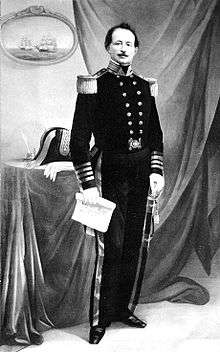
.jpg)



